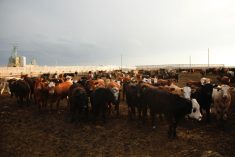The Alberta public will get about a month to speak its mind on proposed changes to provincial labour laws, with the goal of applying those changes to farms and ranches.
The province on Monday released a pair of reports from technical working groups (TWGs) reviewing farm and ranch operations’ status under the Employment Standards Code and Labour Relations Code respectively.
The TWGs’ reports, dated Jan. 3 and 4 respectively, were submitted to Agriculture Minister Oneil Carlier and Labour Minister Christina Gray. Reports from four remaining TWGs are still to be released.
Read Also

Prairie forecast: Potential to turn cool and wet
For this forecast period we are starting off with a large area of high pressure over Ontario and an equally large area of low pressure over the Yukon. The clockwise flow around the Ontario high, combined with the counterclockwise flow around the Yukon low, is creating a widespread southerly flow across the Prairies. This should lead to one more day of warm temperatures across the western Prairies and a couple more days over the eastern half.
Members of the public get until April 3 to provide feedback on the two reports, the province said.
The province said Monday its next steps will be to start drafting legislative amendments “based on the recommendations and public feedback received.”
Carlier, in a release Monday, described the recommendations as an “excellent starting point to ensure waged non-family farm workers have the same rights as other workers, while preserving the way of life that is the foundation of rural Alberta.”
Labour relations
Among its other recommendations, the labour relations TWG’s report proposes to add farm criteria to the Public Emergency Tribunal (PET) provisions of the Labour Relations Code.
The proposal would allow for a PET in cases where there’s an existing or imminent strike or lockout with “imminent and irreversible damage to crops and/or livestock welfare in primary agriculture.”
PETs, a type of compulsory arbitration, can be applied today in Alberta labour disputes that would, if unresolved, result in “damage to health or property” such as disruption of health or water treatment services — or in cases where “unreasonable hardship is placed on persons not involved in the dispute.”
The labour relations TWG also agreed to leave “immediate family” out of the provisions of the Code on farms, on the ground that “inclusion of family members in the bargaining unit would adversely affect family relationships.”
Some members of the labour relations TWG also proposed recommendations that would continue to leave farm workers out of the Code’s provisions or ban farm strikes or lockouts — but those were “not agreed to by all working group members.”
Farm representatives on the TWG “expressed frustration regarding the value and fairness of the consultation process and the limitations of the mandate,” the TWG’s report said. Other TWG members said the mandate was “inappropriately narrow and expressed frustration with discussion that tried to focus on issues that were outside that mandate.”
The TWG, apart from its list of recommendations, listed several not-agreed-upon “strategic options” such as adding the agriculture exemption back into the Code; banning strikes or lockouts for agriculture workers; adopting Ontario’s model, which excludes farm workers from joining a union; and resetting the minimum number of employees required to unionize at five for farms, as opposed to two in other sectors.
Work standards
The employment standards TWG, meanwhile, agreed to continue to apply many existing standards for waged, non-family farm workers, such as for payment, employment records, job-protected leaves, vacations and general holidays, termination and exemptions for farms dealing with work hours and overtime.
The TWG said it also agreed to exempt, or continue to exempt, family-member employees from all standards discussed in the review — “including ones that currently apply.”
Applying those standards, the TWG said, would be “impractical and unfeasible, as well as burdensome without providing any benefit.”
Also, the TWG said, “in cases where family members may be mistreated, members of the TWG identified that the employment standards discussed would not be helpful in preventing such mistreatment.”
The standards TWG also agreed greenhouses, nurseries, sod farms and mushroom farms would be considered “primary production” and would have the same standards and exemptions as “the rest of agriculture.”
Minimum wage rules would apply to “waged, non-family farm and ranch employees,” the TWG said, and for waged, non-family employees under age 16, work “must not be detrimental to health, education, or welfare and parental consent must be obtained by employers.”
For waged, non-family youths aged 12 and 13, the TWG said, there should be a limit of 20 hours of work per week.
The standards TWG also noted a “non-consensus” recommendation that minimum wage for waged, non-family employees under age 16 could be 75 per cent of the general minimum rate. — AGCanada.com Network


















